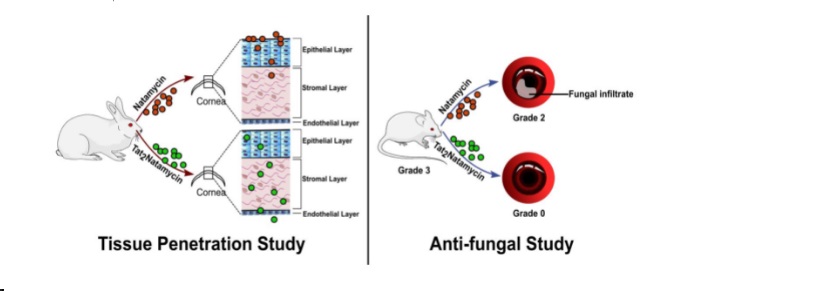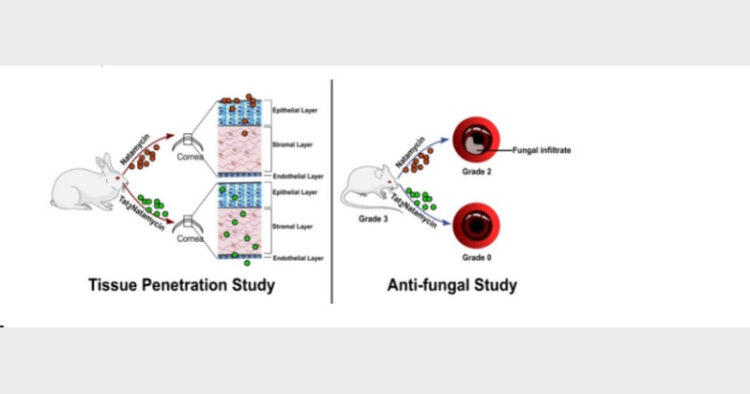New Delhi: IIT Delhi researchers developed a strategy to fight fungal infection of the cornea in eyes causes blindness.

India has a huge agrarian population, which is very prone to vegetative trauma while farming. Infected vegetable matter, such as plant leaves, causes vegetative stress to the eye, which frequently results in a fungal infection of the cornea in the eyes, also known as fungal keratitis.
According to the WHO, fungal keratitis is a leading cause of monocular blindness i.e., blindness in one eye, in the developing world. According to a recent study published in Lancet, the highest annual incidence per 1 lakh people is reported in Southern Asia and India accounts for over 50% of the fungal keratitis cases out of total microbial keratitis cases.
Currently, available drugs for fungal keratitis are less effective, especially in severe diseases because of poor drug penetration, poor bioavailability, and antifungal efficacy. US FDA-approved Natamycin is employed as a primary line of treatment for fungal keratitis but, because of poor ocular penetration, it requires prolonged and frequent dosing, causing discomfort to patients.
To develop a better antifungal strategy for fungal keratitis, an all-women team of IIT Delhi researchers led by Prof. Archana Chugh from Kusuma School of Biological Sciences (along with her Ph.D. students – Dr. Aastha Jain, Harsha Rohira, and Sujithra Shankar) has been working in collaboration with Dr. Sushmita G Shah, Ophthalmologist and Cornea Specialist from Dr. CM Shah Memorial Charitable Trust and Eye Life, Mumbai.
The team has successfully developed a novel peptide-based antifungal strategy for enhanced Natamycin penetration. The developed peptide-drug conjugate showed an appreciable antifungal effect in the lab.
“These peptides are known to have the ability to carry molecules with them in the cells. Therefore, when poorly permeable Natamycin was attached to the peptide, the formed complex showed better antifungal effect”, Prof Archana Chugh said.
In their research study, the scientists found that conjugate drug penetration was 5-fold higher than Natamycin in rabbits, thus enabling lowering of the dosage frequency. Further, 44% of mice showed complete resolution of fungal infection with the novel conjugate compared to 13% of mice that were treated with Natamycin suspension only. The International Journal of Pharmaceutics has recently published the study.
The animal studies were carried out in collaboration with Dr. Shikha Yadav, Head of Animal Facility at the National Institute of Biologicals, NOIDA. The Department of Biotechnology initially funded the research, followed by Nanomission, the Department of Science and Technology, Government of India.
Prof Chugh further said, “This is a great example of “Make in India”; however, a few hurdles persist for us before this novel conjugate can enter the clinics and is useful to patients. With promising results got in animal studies, we are hopeful that the Biotechnology/ Pharmaceutical industry will come forward for its clinical trials.” Dr. Sushmita G Shah, Ophthalmologist & Cornea Specialist, Eye Life, Mumbai said, “Collaboration hope clinicians and scientists are important to develop newer and better drugs, diagnostic devices, etc., which can improve patient care. We are very excited with the results got so far and look forward to starting a clinical trial with the participation of the Industry and other relevant agencies.”
While speaking of the research study by the team led by Prof Chugh, Dr. Virender Singh Sangwan, Director Innovations, Dr. Shroff’s Charity Eye Hospital, New Delhi said, “The study clearly demonstrated enhanced penetration and effectiveness of a conjugated form of Natamycin to treat fungal keratitis. In India and most of the developing countries, fungal keratitis is a significant public health problem and is responsible for almost 50% of cases of keratitis. Currently, available treatment such as Natamycin has poor penetration of the drug into the cornea and hence results in delayed response to treatment.”
Courtesy: (India Science Wire)














Comments